Impact of Capital Structure on Firm's Profitability in Retail Sector
VerifiedAdded on 2023/01/18
|9
|1619
|23
AI Summary
This research proposal aims to investigate the impact of capital structure on firm's profitability in the context of the retail sector, focusing on Tesco, Morrisons, and Sainsbury. The study will analyze the concept of capital structure, evaluate factors affecting capital structure, explore ways to attain optimum capital structure, and analyze the interrelationship between capital structure and profitability.
Contribute Materials
Your contribution can guide someone’s learning journey. Share your
documents today.
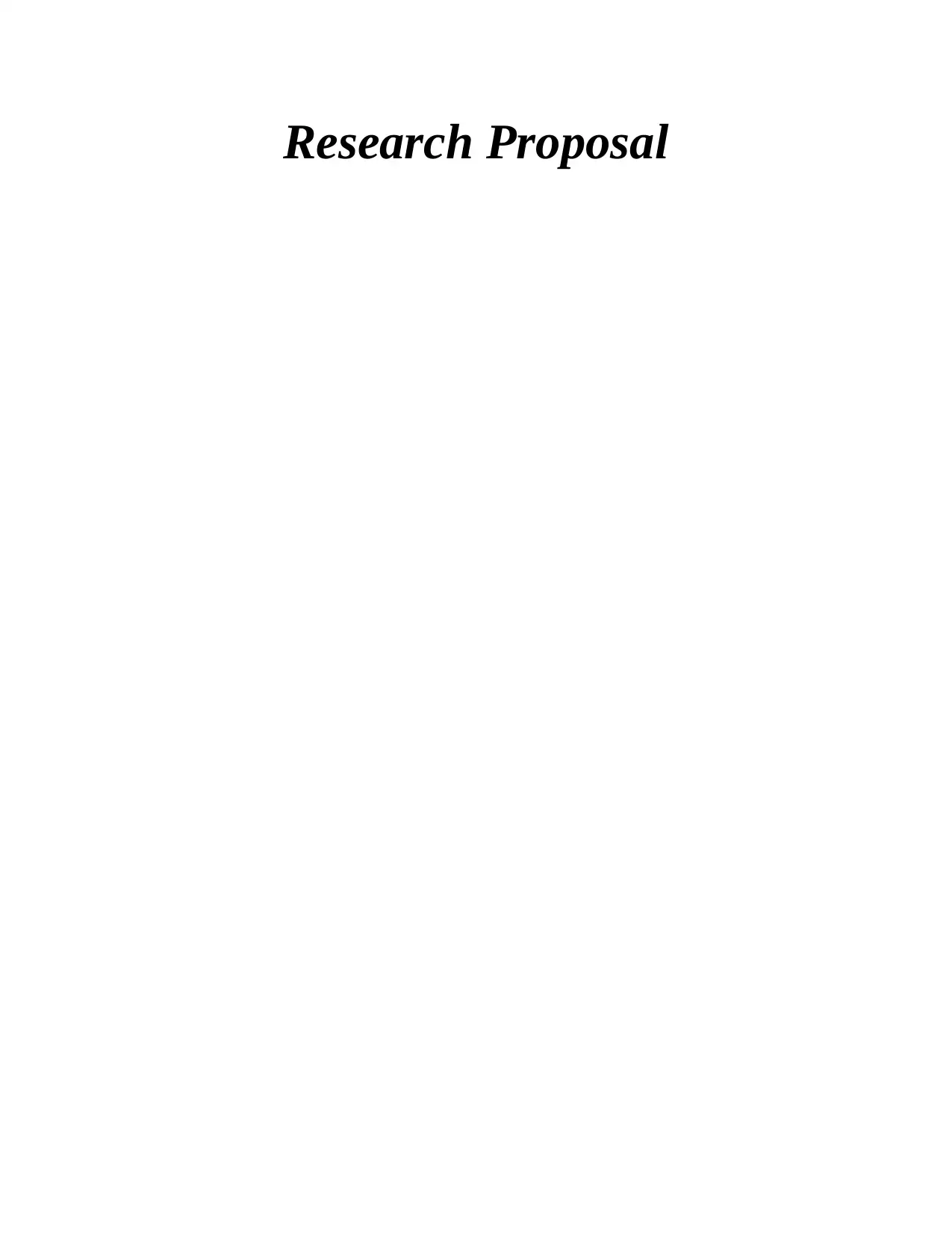
Research Proposal
Secure Best Marks with AI Grader
Need help grading? Try our AI Grader for instant feedback on your assignments.
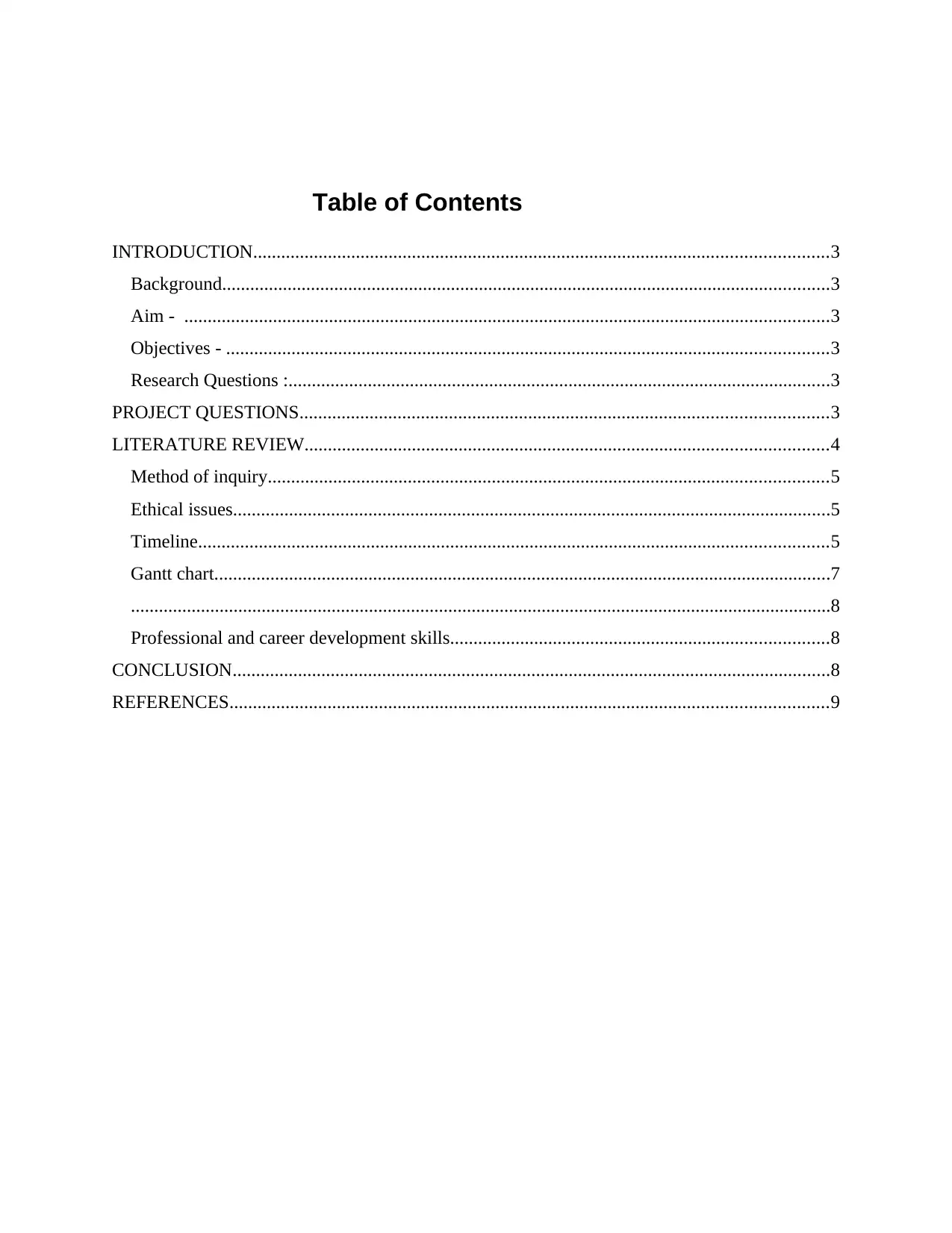
Table of Contents
INTRODUCTION...........................................................................................................................3
Background..................................................................................................................................3
Aim - ..........................................................................................................................................3
Objectives - .................................................................................................................................3
Research Questions :....................................................................................................................3
PROJECT QUESTIONS.................................................................................................................3
LITERATURE REVIEW................................................................................................................4
Method of inquiry........................................................................................................................5
Ethical issues................................................................................................................................5
Timeline.......................................................................................................................................5
Gantt chart....................................................................................................................................7
......................................................................................................................................................8
Professional and career development skills.................................................................................8
CONCLUSION................................................................................................................................8
REFERENCES................................................................................................................................9
INTRODUCTION...........................................................................................................................3
Background..................................................................................................................................3
Aim - ..........................................................................................................................................3
Objectives - .................................................................................................................................3
Research Questions :....................................................................................................................3
PROJECT QUESTIONS.................................................................................................................3
LITERATURE REVIEW................................................................................................................4
Method of inquiry........................................................................................................................5
Ethical issues................................................................................................................................5
Timeline.......................................................................................................................................5
Gantt chart....................................................................................................................................7
......................................................................................................................................................8
Professional and career development skills.................................................................................8
CONCLUSION................................................................................................................................8
REFERENCES................................................................................................................................9
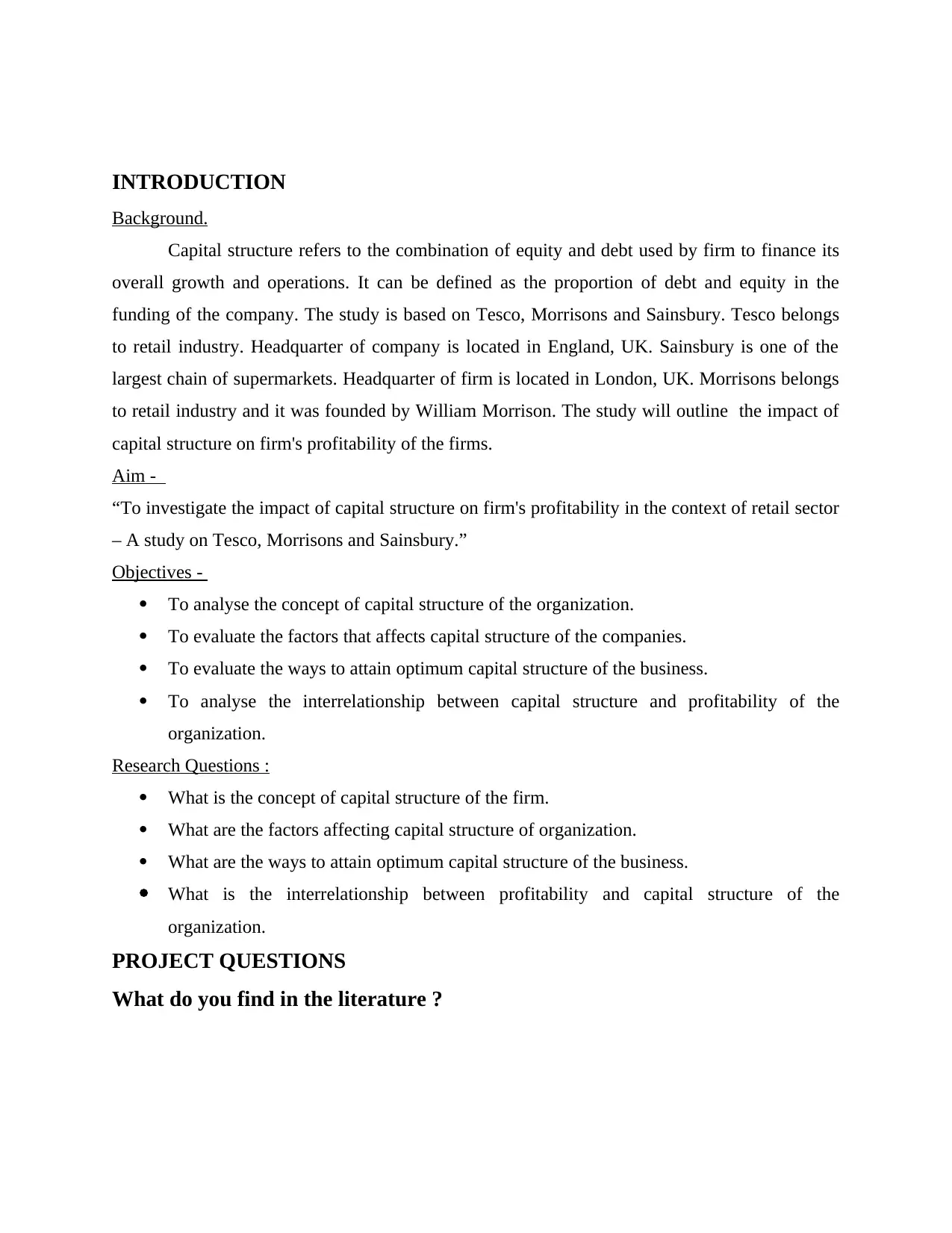
INTRODUCTION
Background.
Capital structure refers to the combination of equity and debt used by firm to finance its
overall growth and operations. It can be defined as the proportion of debt and equity in the
funding of the company. The study is based on Tesco, Morrisons and Sainsbury. Tesco belongs
to retail industry. Headquarter of company is located in England, UK. Sainsbury is one of the
largest chain of supermarkets. Headquarter of firm is located in London, UK. Morrisons belongs
to retail industry and it was founded by William Morrison. The study will outline the impact of
capital structure on firm's profitability of the firms.
Aim -
“To investigate the impact of capital structure on firm's profitability in the context of retail sector
– A study on Tesco, Morrisons and Sainsbury.”
Objectives -
To analyse the concept of capital structure of the organization.
To evaluate the factors that affects capital structure of the companies.
To evaluate the ways to attain optimum capital structure of the business.
To analyse the interrelationship between capital structure and profitability of the
organization.
Research Questions :
What is the concept of capital structure of the firm.
What are the factors affecting capital structure of organization.
What are the ways to attain optimum capital structure of the business.
What is the interrelationship between profitability and capital structure of the
organization.
PROJECT QUESTIONS
What do you find in the literature ?
Background.
Capital structure refers to the combination of equity and debt used by firm to finance its
overall growth and operations. It can be defined as the proportion of debt and equity in the
funding of the company. The study is based on Tesco, Morrisons and Sainsbury. Tesco belongs
to retail industry. Headquarter of company is located in England, UK. Sainsbury is one of the
largest chain of supermarkets. Headquarter of firm is located in London, UK. Morrisons belongs
to retail industry and it was founded by William Morrison. The study will outline the impact of
capital structure on firm's profitability of the firms.
Aim -
“To investigate the impact of capital structure on firm's profitability in the context of retail sector
– A study on Tesco, Morrisons and Sainsbury.”
Objectives -
To analyse the concept of capital structure of the organization.
To evaluate the factors that affects capital structure of the companies.
To evaluate the ways to attain optimum capital structure of the business.
To analyse the interrelationship between capital structure and profitability of the
organization.
Research Questions :
What is the concept of capital structure of the firm.
What are the factors affecting capital structure of organization.
What are the ways to attain optimum capital structure of the business.
What is the interrelationship between profitability and capital structure of the
organization.
PROJECT QUESTIONS
What do you find in the literature ?
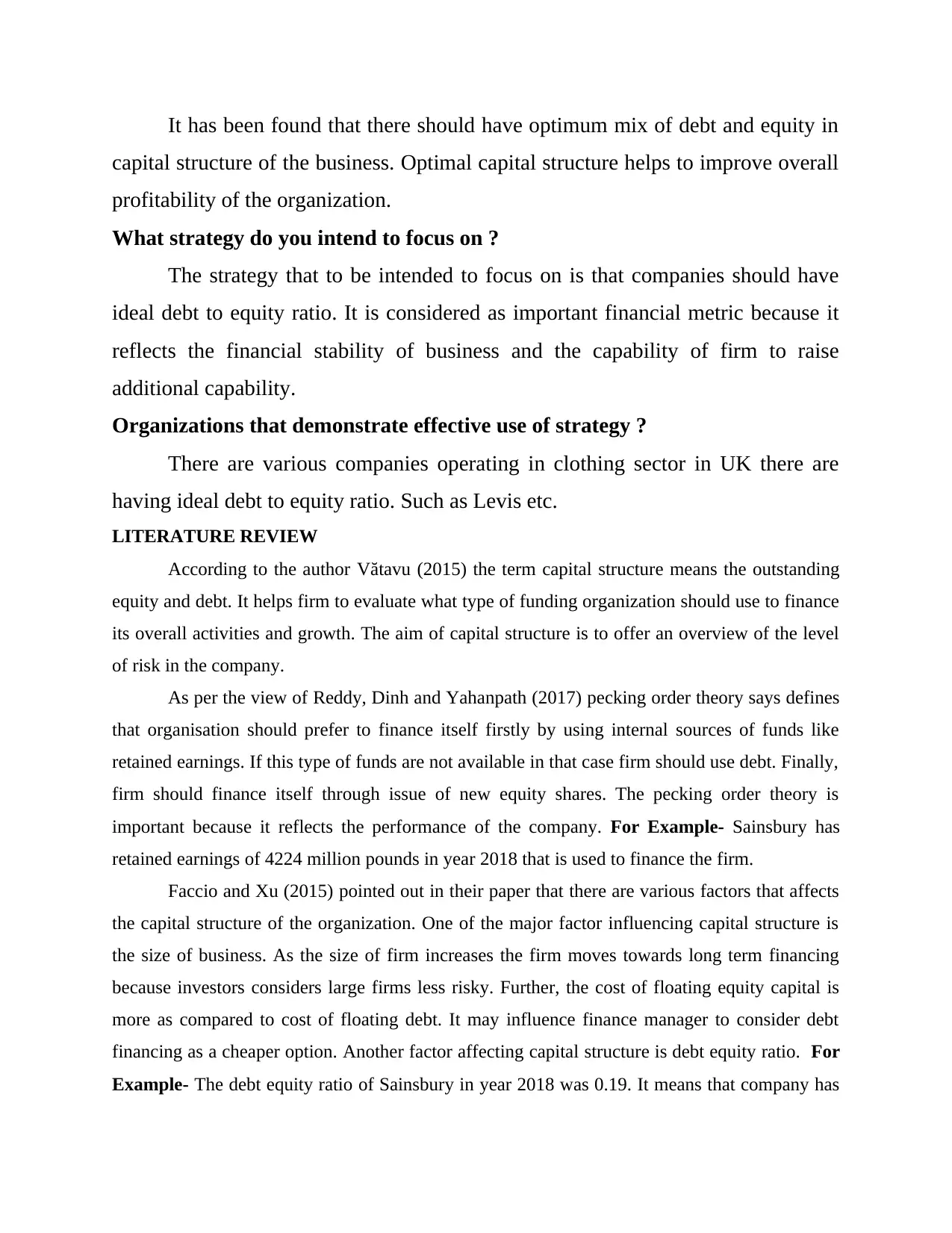
It has been found that there should have optimum mix of debt and equity in
capital structure of the business. Optimal capital structure helps to improve overall
profitability of the organization.
What strategy do you intend to focus on ?
The strategy that to be intended to focus on is that companies should have
ideal debt to equity ratio. It is considered as important financial metric because it
reflects the financial stability of business and the capability of firm to raise
additional capability.
Organizations that demonstrate effective use of strategy ?
There are various companies operating in clothing sector in UK there are
having ideal debt to equity ratio. Such as Levis etc.
LITERATURE REVIEW
According to the author Vătavu (2015) the term capital structure means the outstanding
equity and debt. It helps firm to evaluate what type of funding organization should use to finance
its overall activities and growth. The aim of capital structure is to offer an overview of the level
of risk in the company.
As per the view of Reddy, Dinh and Yahanpath (2017) pecking order theory says defines
that organisation should prefer to finance itself firstly by using internal sources of funds like
retained earnings. If this type of funds are not available in that case firm should use debt. Finally,
firm should finance itself through issue of new equity shares. The pecking order theory is
important because it reflects the performance of the company. For Example- Sainsbury has
retained earnings of 4224 million pounds in year 2018 that is used to finance the firm.
Faccio and Xu (2015) pointed out in their paper that there are various factors that affects
the capital structure of the organization. One of the major factor influencing capital structure is
the size of business. As the size of firm increases the firm moves towards long term financing
because investors considers large firms less risky. Further, the cost of floating equity capital is
more as compared to cost of floating debt. It may influence finance manager to consider debt
financing as a cheaper option. Another factor affecting capital structure is debt equity ratio. For
Example- The debt equity ratio of Sainsbury in year 2018 was 0.19. It means that company has
capital structure of the business. Optimal capital structure helps to improve overall
profitability of the organization.
What strategy do you intend to focus on ?
The strategy that to be intended to focus on is that companies should have
ideal debt to equity ratio. It is considered as important financial metric because it
reflects the financial stability of business and the capability of firm to raise
additional capability.
Organizations that demonstrate effective use of strategy ?
There are various companies operating in clothing sector in UK there are
having ideal debt to equity ratio. Such as Levis etc.
LITERATURE REVIEW
According to the author Vătavu (2015) the term capital structure means the outstanding
equity and debt. It helps firm to evaluate what type of funding organization should use to finance
its overall activities and growth. The aim of capital structure is to offer an overview of the level
of risk in the company.
As per the view of Reddy, Dinh and Yahanpath (2017) pecking order theory says defines
that organisation should prefer to finance itself firstly by using internal sources of funds like
retained earnings. If this type of funds are not available in that case firm should use debt. Finally,
firm should finance itself through issue of new equity shares. The pecking order theory is
important because it reflects the performance of the company. For Example- Sainsbury has
retained earnings of 4224 million pounds in year 2018 that is used to finance the firm.
Faccio and Xu (2015) pointed out in their paper that there are various factors that affects
the capital structure of the organization. One of the major factor influencing capital structure is
the size of business. As the size of firm increases the firm moves towards long term financing
because investors considers large firms less risky. Further, the cost of floating equity capital is
more as compared to cost of floating debt. It may influence finance manager to consider debt
financing as a cheaper option. Another factor affecting capital structure is debt equity ratio. For
Example- The debt equity ratio of Sainsbury in year 2018 was 0.19. It means that company has
Secure Best Marks with AI Grader
Need help grading? Try our AI Grader for instant feedback on your assignments.
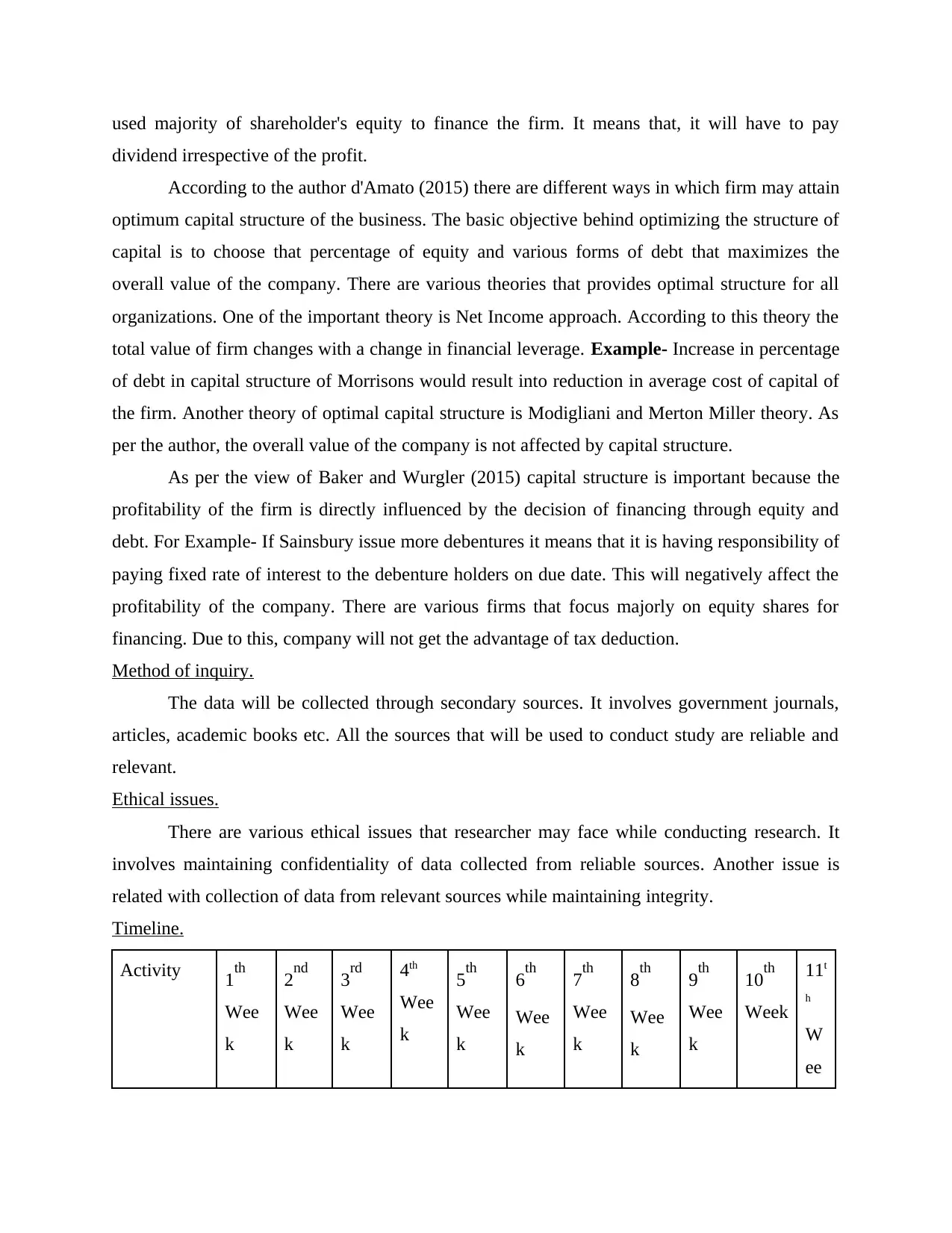
used majority of shareholder's equity to finance the firm. It means that, it will have to pay
dividend irrespective of the profit.
According to the author d'Amato (2015) there are different ways in which firm may attain
optimum capital structure of the business. The basic objective behind optimizing the structure of
capital is to choose that percentage of equity and various forms of debt that maximizes the
overall value of the company. There are various theories that provides optimal structure for all
organizations. One of the important theory is Net Income approach. According to this theory the
total value of firm changes with a change in financial leverage. Example- Increase in percentage
of debt in capital structure of Morrisons would result into reduction in average cost of capital of
the firm. Another theory of optimal capital structure is Modigliani and Merton Miller theory. As
per the author, the overall value of the company is not affected by capital structure.
As per the view of Baker and Wurgler (2015) capital structure is important because the
profitability of the firm is directly influenced by the decision of financing through equity and
debt. For Example- If Sainsbury issue more debentures it means that it is having responsibility of
paying fixed rate of interest to the debenture holders on due date. This will negatively affect the
profitability of the company. There are various firms that focus majorly on equity shares for
financing. Due to this, company will not get the advantage of tax deduction.
Method of inquiry.
The data will be collected through secondary sources. It involves government journals,
articles, academic books etc. All the sources that will be used to conduct study are reliable and
relevant.
Ethical issues.
There are various ethical issues that researcher may face while conducting research. It
involves maintaining confidentiality of data collected from reliable sources. Another issue is
related with collection of data from relevant sources while maintaining integrity.
Timeline.
Activity 1th
Wee
k
2nd
Wee
k
3rd
Wee
k
4th
Wee
k
5th
Wee
k
6th
Wee
k
7th
Wee
k
8th
Wee
k
9th
Wee
k
10th
Week
11t
h
W
ee
dividend irrespective of the profit.
According to the author d'Amato (2015) there are different ways in which firm may attain
optimum capital structure of the business. The basic objective behind optimizing the structure of
capital is to choose that percentage of equity and various forms of debt that maximizes the
overall value of the company. There are various theories that provides optimal structure for all
organizations. One of the important theory is Net Income approach. According to this theory the
total value of firm changes with a change in financial leverage. Example- Increase in percentage
of debt in capital structure of Morrisons would result into reduction in average cost of capital of
the firm. Another theory of optimal capital structure is Modigliani and Merton Miller theory. As
per the author, the overall value of the company is not affected by capital structure.
As per the view of Baker and Wurgler (2015) capital structure is important because the
profitability of the firm is directly influenced by the decision of financing through equity and
debt. For Example- If Sainsbury issue more debentures it means that it is having responsibility of
paying fixed rate of interest to the debenture holders on due date. This will negatively affect the
profitability of the company. There are various firms that focus majorly on equity shares for
financing. Due to this, company will not get the advantage of tax deduction.
Method of inquiry.
The data will be collected through secondary sources. It involves government journals,
articles, academic books etc. All the sources that will be used to conduct study are reliable and
relevant.
Ethical issues.
There are various ethical issues that researcher may face while conducting research. It
involves maintaining confidentiality of data collected from reliable sources. Another issue is
related with collection of data from relevant sources while maintaining integrity.
Timeline.
Activity 1th
Wee
k
2nd
Wee
k
3rd
Wee
k
4th
Wee
k
5th
Wee
k
6th
Wee
k
7th
Wee
k
8th
Wee
k
9th
Wee
k
10th
Week
11t
h
W
ee
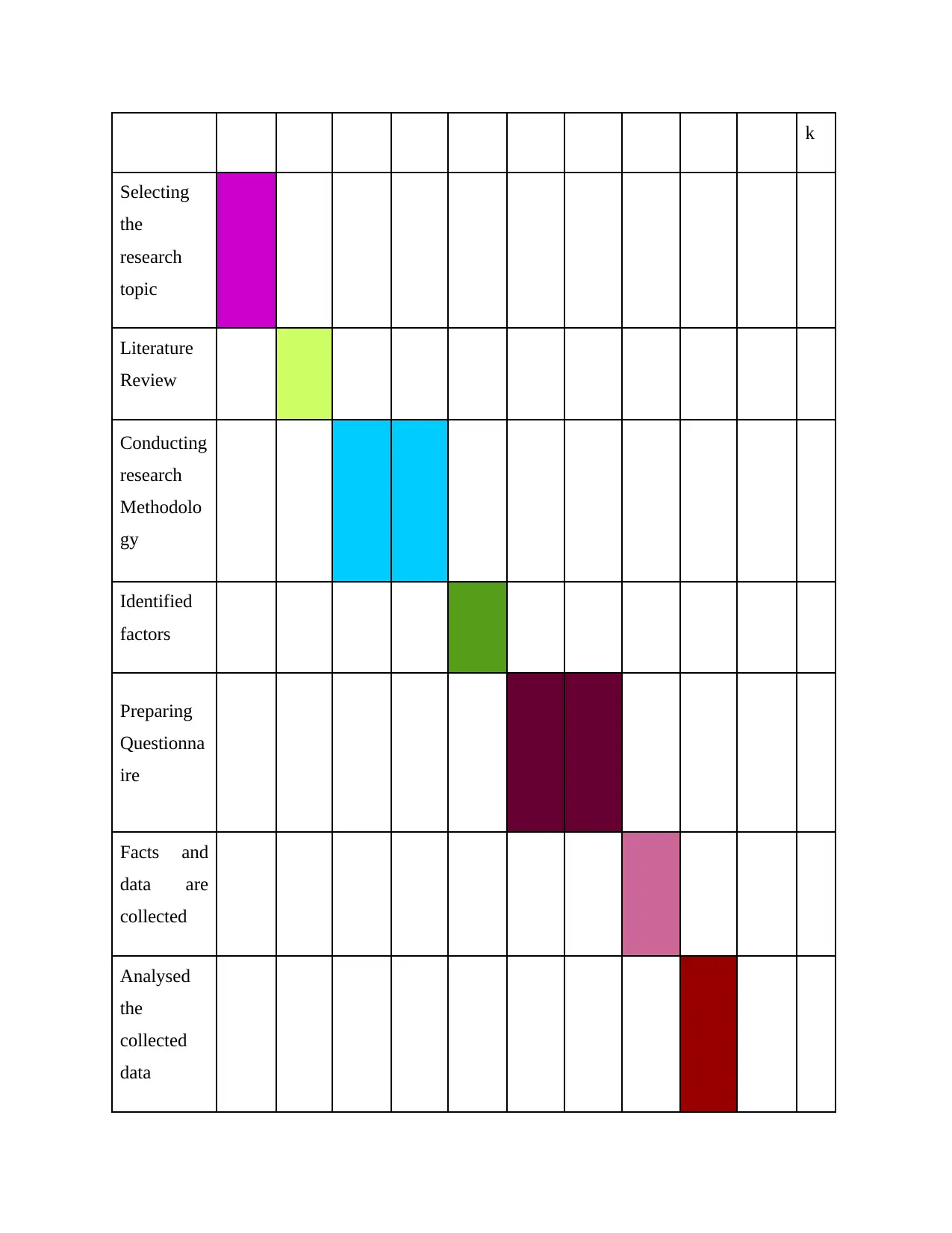
k
Selecting
the
research
topic
Literature
Review
Conducting
research
Methodolo
gy
Identified
factors
Preparing
Questionna
ire
Facts and
data are
collected
Analysed
the
collected
data
Selecting
the
research
topic
Literature
Review
Conducting
research
Methodolo
gy
Identified
factors
Preparing
Questionna
ire
Facts and
data are
collected
Analysed
the
collected
data
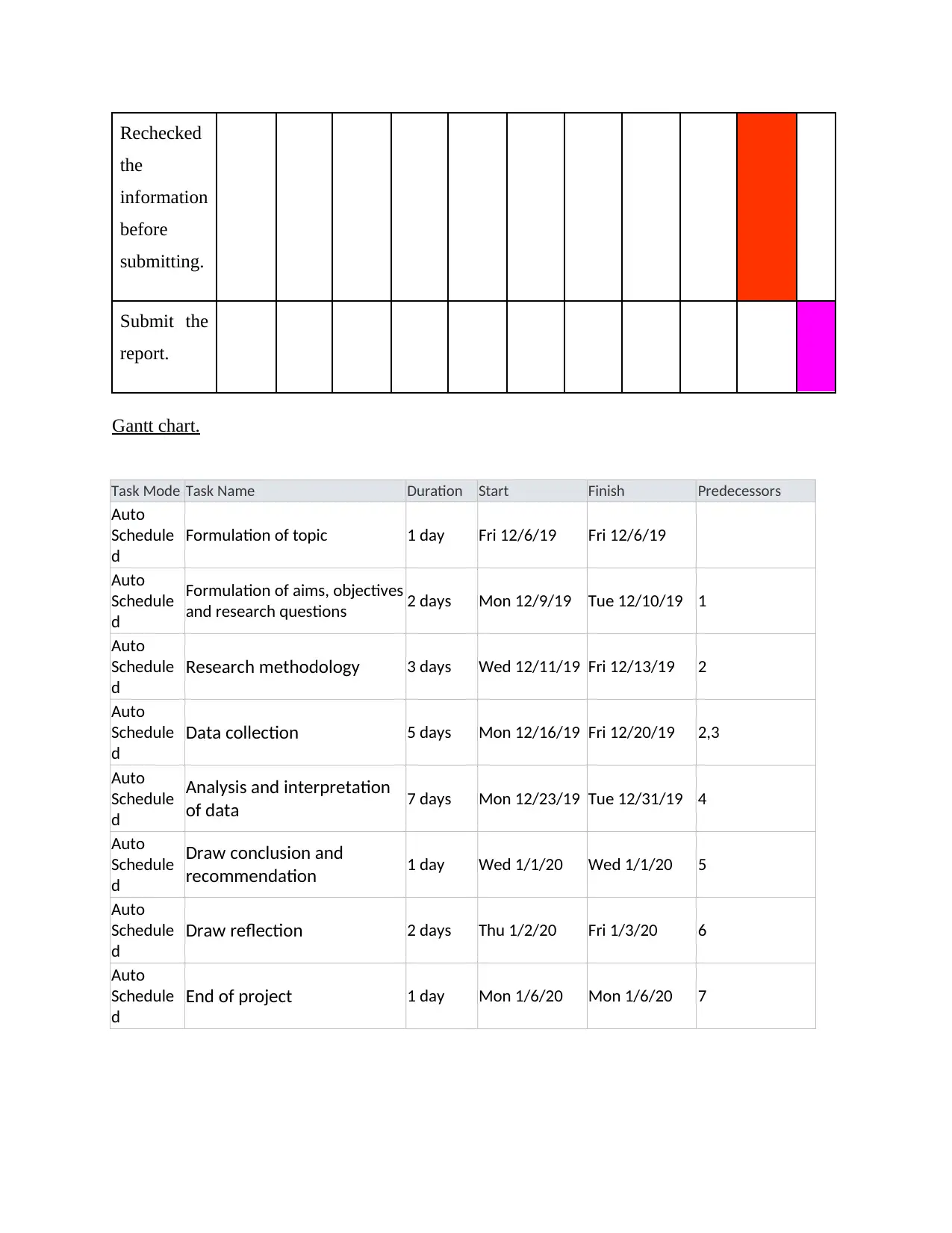
Rechecked
the
information
before
submitting.
Submit the
report.
Gantt chart.
Task Mode Task Name Duration Start Finish Predecessors
Auto
Schedule
d
Formulation of topic 1 day Fri 12/6/19 Fri 12/6/19
Auto
Schedule
d
Formulation of aims, objectives
and research questions 2 days Mon 12/9/19 Tue 12/10/19 1
Auto
Schedule
d
Research methodology 3 days Wed 12/11/19 Fri 12/13/19 2
Auto
Schedule
d
Data collection 5 days Mon 12/16/19 Fri 12/20/19 2,3
Auto
Schedule
d
Analysis and interpretation
of data 7 days Mon 12/23/19 Tue 12/31/19 4
Auto
Schedule
d
Draw conclusion and
recommendation 1 day Wed 1/1/20 Wed 1/1/20 5
Auto
Schedule
d
Draw reflection 2 days Thu 1/2/20 Fri 1/3/20 6
Auto
Schedule
d
End of project 1 day Mon 1/6/20 Mon 1/6/20 7
the
information
before
submitting.
Submit the
report.
Gantt chart.
Task Mode Task Name Duration Start Finish Predecessors
Auto
Schedule
d
Formulation of topic 1 day Fri 12/6/19 Fri 12/6/19
Auto
Schedule
d
Formulation of aims, objectives
and research questions 2 days Mon 12/9/19 Tue 12/10/19 1
Auto
Schedule
d
Research methodology 3 days Wed 12/11/19 Fri 12/13/19 2
Auto
Schedule
d
Data collection 5 days Mon 12/16/19 Fri 12/20/19 2,3
Auto
Schedule
d
Analysis and interpretation
of data 7 days Mon 12/23/19 Tue 12/31/19 4
Auto
Schedule
d
Draw conclusion and
recommendation 1 day Wed 1/1/20 Wed 1/1/20 5
Auto
Schedule
d
Draw reflection 2 days Thu 1/2/20 Fri 1/3/20 6
Auto
Schedule
d
End of project 1 day Mon 1/6/20 Mon 1/6/20 7
Paraphrase This Document
Need a fresh take? Get an instant paraphrase of this document with our AI Paraphraser
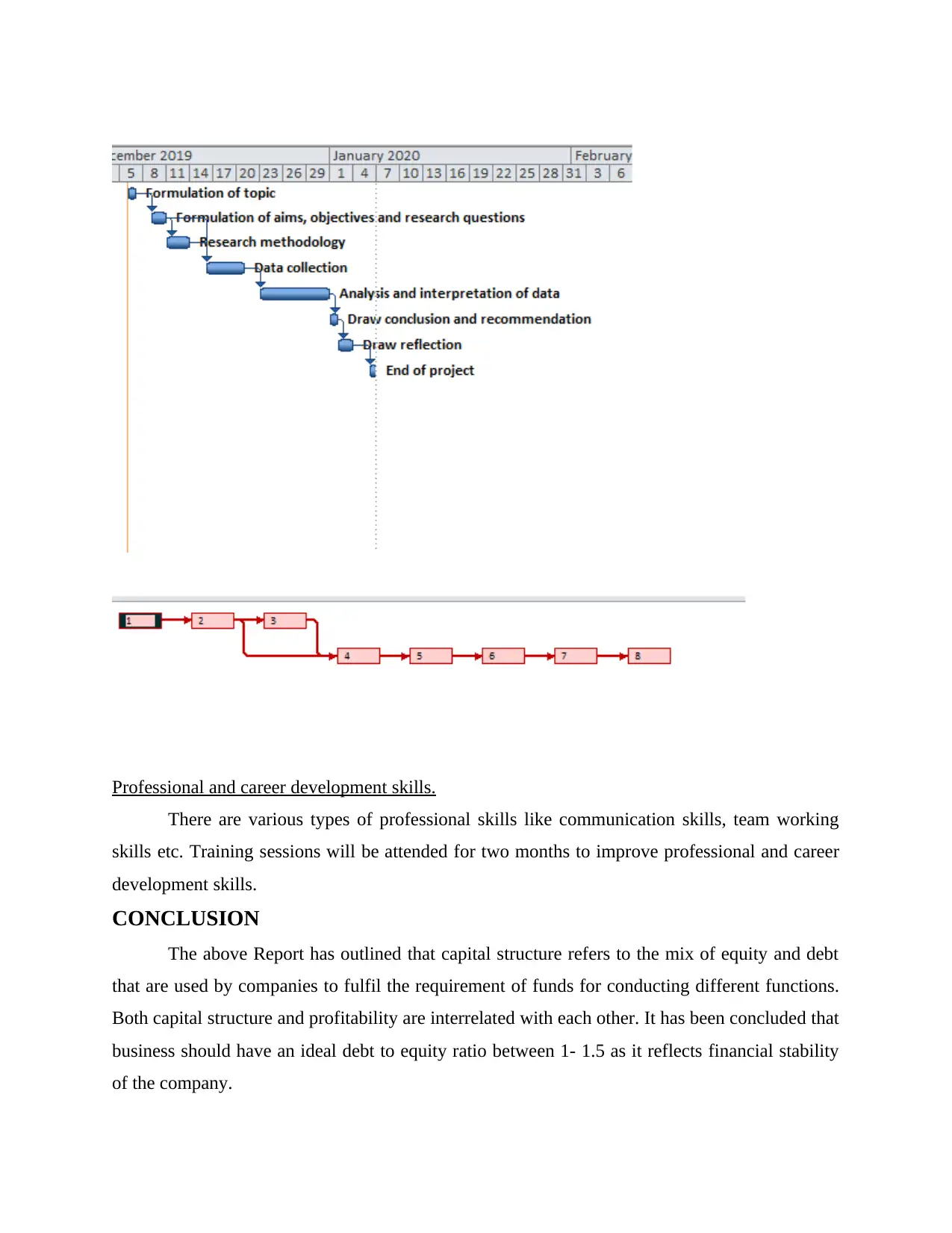
Professional and career development skills.
There are various types of professional skills like communication skills, team working
skills etc. Training sessions will be attended for two months to improve professional and career
development skills.
CONCLUSION
The above Report has outlined that capital structure refers to the mix of equity and debt
that are used by companies to fulfil the requirement of funds for conducting different functions.
Both capital structure and profitability are interrelated with each other. It has been concluded that
business should have an ideal debt to equity ratio between 1- 1.5 as it reflects financial stability
of the company.
There are various types of professional skills like communication skills, team working
skills etc. Training sessions will be attended for two months to improve professional and career
development skills.
CONCLUSION
The above Report has outlined that capital structure refers to the mix of equity and debt
that are used by companies to fulfil the requirement of funds for conducting different functions.
Both capital structure and profitability are interrelated with each other. It has been concluded that
business should have an ideal debt to equity ratio between 1- 1.5 as it reflects financial stability
of the company.
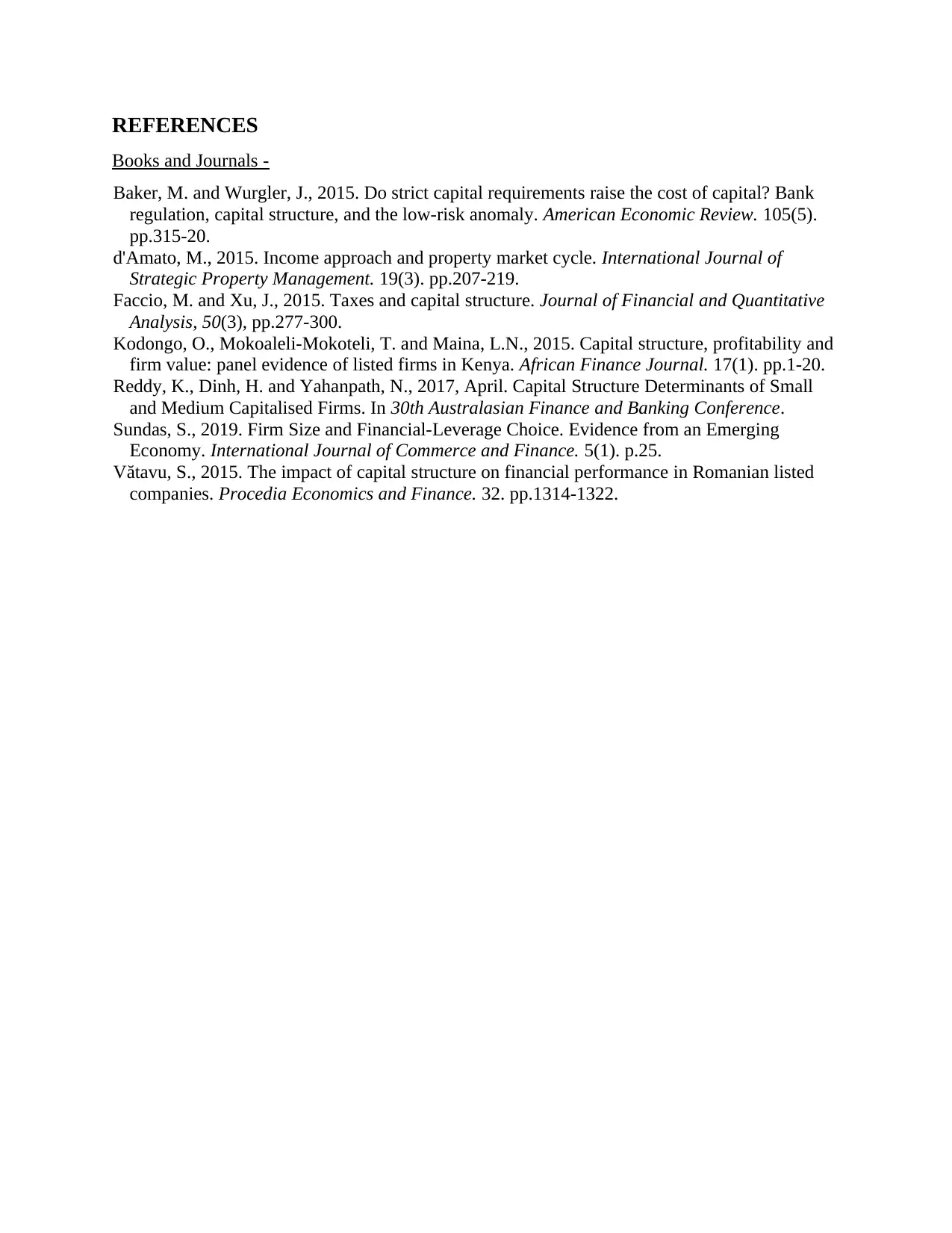
REFERENCES
Books and Journals -
Baker, M. and Wurgler, J., 2015. Do strict capital requirements raise the cost of capital? Bank
regulation, capital structure, and the low-risk anomaly. American Economic Review. 105(5).
pp.315-20.
d'Amato, M., 2015. Income approach and property market cycle. International Journal of
Strategic Property Management. 19(3). pp.207-219.
Faccio, M. and Xu, J., 2015. Taxes and capital structure. Journal of Financial and Quantitative
Analysis, 50(3), pp.277-300.
Kodongo, O., Mokoaleli-Mokoteli, T. and Maina, L.N., 2015. Capital structure, profitability and
firm value: panel evidence of listed firms in Kenya. African Finance Journal. 17(1). pp.1-20.
Reddy, K., Dinh, H. and Yahanpath, N., 2017, April. Capital Structure Determinants of Small
and Medium Capitalised Firms. In 30th Australasian Finance and Banking Conference.
Sundas, S., 2019. Firm Size and Financial-Leverage Choice. Evidence from an Emerging
Economy. International Journal of Commerce and Finance. 5(1). p.25.
Vătavu, S., 2015. The impact of capital structure on financial performance in Romanian listed
companies. Procedia Economics and Finance. 32. pp.1314-1322.
Books and Journals -
Baker, M. and Wurgler, J., 2015. Do strict capital requirements raise the cost of capital? Bank
regulation, capital structure, and the low-risk anomaly. American Economic Review. 105(5).
pp.315-20.
d'Amato, M., 2015. Income approach and property market cycle. International Journal of
Strategic Property Management. 19(3). pp.207-219.
Faccio, M. and Xu, J., 2015. Taxes and capital structure. Journal of Financial and Quantitative
Analysis, 50(3), pp.277-300.
Kodongo, O., Mokoaleli-Mokoteli, T. and Maina, L.N., 2015. Capital structure, profitability and
firm value: panel evidence of listed firms in Kenya. African Finance Journal. 17(1). pp.1-20.
Reddy, K., Dinh, H. and Yahanpath, N., 2017, April. Capital Structure Determinants of Small
and Medium Capitalised Firms. In 30th Australasian Finance and Banking Conference.
Sundas, S., 2019. Firm Size and Financial-Leverage Choice. Evidence from an Emerging
Economy. International Journal of Commerce and Finance. 5(1). p.25.
Vătavu, S., 2015. The impact of capital structure on financial performance in Romanian listed
companies. Procedia Economics and Finance. 32. pp.1314-1322.
1 out of 9
Related Documents
Your All-in-One AI-Powered Toolkit for Academic Success.
+13062052269
info@desklib.com
Available 24*7 on WhatsApp / Email
![[object Object]](/_next/static/media/star-bottom.7253800d.svg)
Unlock your academic potential
© 2024 | Zucol Services PVT LTD | All rights reserved.





